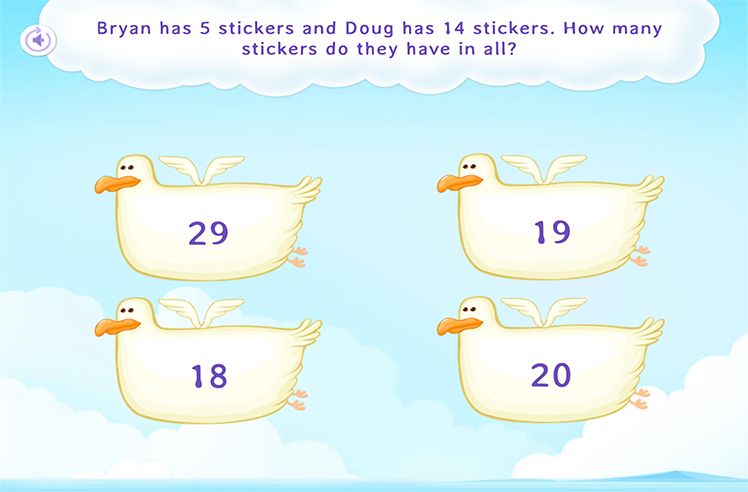What Is Binary Addition?
The number system that has the base “2” is called a binary number system. It uses only two numbers, 0 and 1. Each digit in the binary number system is known as a “bit.” Binary bits “0” and “1” stand for “LOW” and “HIGH,” or “OFF” and “ON” respectively. Let’s take a look at some equivalent values of decimal and binary addition.
Binary addition is done in the same way as we add two or more numbers in a decimal number system. We start adding digits from the right. We can use an online Binary Calculator for instant binary addition.
Let’s take a look at binary equivalents of $1 –10$ numbers, which will be useful as we start learning binary addition.
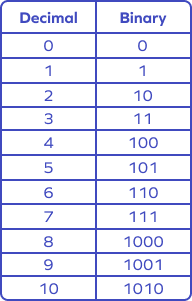
Recommended Games
Definition of Binary Addition
Binary addition can be defined as the method of adding two binary numbers. It follows a set of rules. The rules are framed; for example, the answer to the binary addition and decimal addition is the same. Consider an example.
$2 + 1 = 3$ in decimal addition.
In binary addition, we get
$10_{2} + 1_{2} = 11_{2}$, which represents 3 in the decimal number system.
Binary addition is pretty similar to decimal addition. However, since the base is 2, we have to understand how to use a carryover. In decimal addition, when we get $7 + 3 = 10$, we write 0 and take 1 as a carryover. Similarly, in binary addition, when you get $1 + 1 = 2$, which is 10 in the decimal system, we write 0 and take a carry of 1. Let’s understand this in detail!
Recommended Worksheets
Rules of Binary Addition
Adding in binary is significantly simpler than adding in decimal when you keep in mind the following tips or guidelines. Let’s take a look at the rules of binary addition.
Rule 1: $0 + 0 = 0$; Carry $= 0$
Rule 2: $0 + 1 = 1$; Carry $= 0$
Rule 3: $1 + 0 = 1$; Carry $= 0$
Rule 4: $1 + 1 = 0$; Carry $= 1$
We can summarize this as:
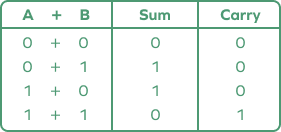
Binary Addition Table
The table of adding two binary numbers 0 and 1 is given below:
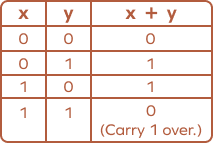
In this table, x and y are the two binary numbers. So when we give the input for $x = 0$ and $y = 0$,
then the output is equal to 0. When $x = 0$ or 1 and $y = 1$ or 0, then $x + y = 1$. But when both x and y are equal to 1, then their addition equals 0, but the carryover number will equal to 1, which means basically $1 + 1 = 10$ in binary addition, where 1 is carried forward to the next digit.
How to Do Binary Addition
Addition of binary numbers includes two cases:
- Binary addition with regrouping
- Binary addition without regrouping
Let us understand binary addition step by step.
Binary Addition with Regrouping
Regrouping is necessary when the sum of two or more binary digits is greater than 1. Let’s add binary numbers $1011_{2}$ and $111_{2}$ to understand it better.
Step 1: Write the numbers such that their respective place values are aligned.

Step 2: Add the digits at ones place using the binary addition rules.
Now, according to binary addition rules, $1 + 1 = 10$.
Thus, we will write 0 at the bottom and take 1 as a carryover to the next place value.

Step 3: Move to the next column on the left, following the rules, $1 + 1 + 1 = 10 + 1$. We will again write 1 at the bottom and take 1 as a carryover to the next place value.

Step 4: Completing the next column in the similar way, we get

Step 5: Now coming to the final column, as it is the last column left, we will not take 1 as carryover. Instead, we will write 10 as the result at the bottom.

Hence, $1011_{2} + 111_{2} = 10010_{2}$
Binary Addition without Regrouping
When the addition of two or more binary digits is 0 or 1, regrouping is not necessary. Let’s add binary numbers $100_{2}$ and $11_{2}$ to understand it better.
Step 1: Arrange the numbers such that the place values are aligned.
Step 2: Start adding from the rightmost column. Here, we first add 0 and 1. According to binary addition rules, $0 + 1 = 1$. There is no carryover here.
Step 3: Similarly, there is no carryover when we add the digits in the next columns. We get:

Hence, $100_{2} + 11_{2} = 111_{2}$
Binary Addition Using 1’s Complement
There are two types of complements of any binary number—1’s complement and 2’s complement. 1’s complement is used in signed binary representation. By using 1’s complement, we can add two negative binary numbers; we can also add one negative number and a positive number.
Two important things to remember in binary addition are:
- The number 0 represents the positive sign
- The number 1 represents the negative sign
To find the 1’s complement of a number we replace every 0 by 1 and every 1 by 0 in a binary number.
For example, the 1’s complement of the binary number 101 is 010.
Let us learn how to add a positive number to a negative number.
When the positive number is greater, we find the 1’s complement of the negative number.
For example, let us add $1011$ to $(-1010)$. We will calculate $1011\;-\;1010$.
Here, $+ 1011 \rightarrow 0 1011$
$-1010 \rightarrow 1 0101$ (taking 1s complement)
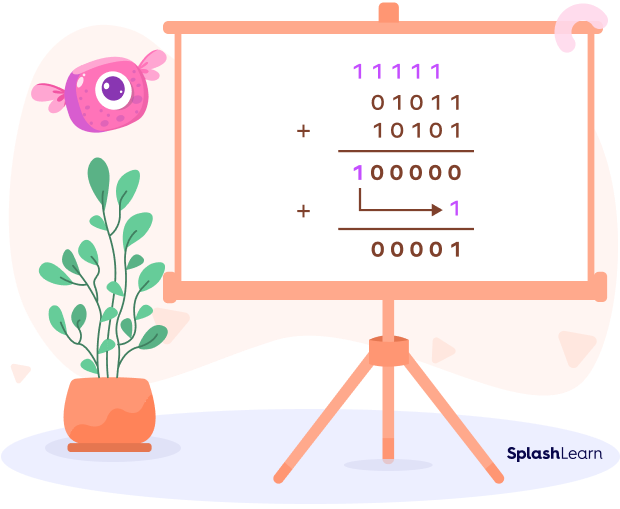
Here, the carryover 1 that we got in the end (end-around carry) is again added to the result 0000. We get $00000 + 1 = 00001$
$1011_{2} + 0101_{2} = 0001_{2}$
When the negative number has greater magnitude, we take the 1’s complement of the negative number. There will be no end-around carry (the carryover we get in the end) in this case. Finally, the sum is obtained by taking the 1’s complement of the result.
Let’s add $1101$ and $-1110$.
Here,
$+ 1101 \rightarrow 0 1101$
$-1110\rightarrow 1 0001$ (taking 1’s complement)
Now, adding both numbers, we get
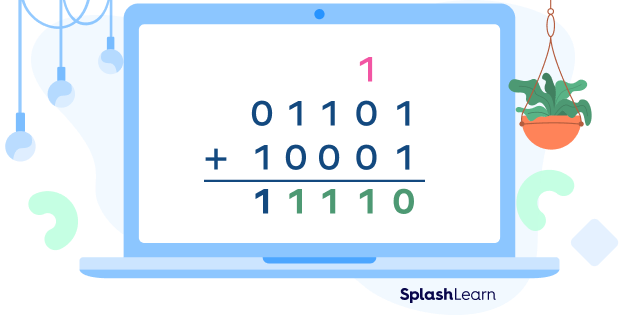
Final answer $= -0001_{2}$ … taking 1’s complement and using the sign bit
Fun Facts!
- Binary as a system can be traced all the way back to the 1560s. It was Thomas Harriot, an English mathematician, who discovered the binary system.
- A binary code is adopted into various languages used today, including braille.
- Binary numbers and their operations are used for various purposes, such as making electrical device circuits. These operations are highly used in computer technology, where 0 indicates the OFF state of the circuit, and 1 indicates its ON state.
- Binary number systems perform all the arithmetic operations like addition, subtraction, multiplication, and division.
- If the last digit of a binary number is 1, the number is odd; if it’s 0, the number is even. Ex: 1101 represents an odd number (13); 10010 represents an even number (18).
Conclusion
In this article, we learned in detail about the binary addition definition, rules, and facts. Let’s solve some examples and practice problems to understand the concept better.
Solved Examples
1. Solve: $1 1 1 0 0_{2} + 1 0 1 0 1_{2}$
Solution:
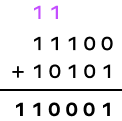
Therefore, $1 1 1 0 0_{2} + 1 0 1 0 1_{2} = 1 1 0 0 0 1_{2}$
2. Find $1 1 0 1 1 0_{2} + 1 1 1 1_{2}$.
Solution:
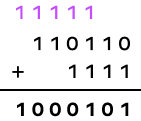
Therefore, $1 1 0 1 1 0_{2} + 1 1 1 1_{2} = 1 0 0 0 1 0 1_{2}$
3. Add $110_{2} + 111_{2} + 101_{2}$
Solution:
To perform the addition of three binary numbers, add two binary numbers together and then add the resultant value with the third one.
Let’s add $110 + 111$ first.
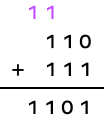
Now, let’s add the third binary number to the resultant value of addition of the first two.
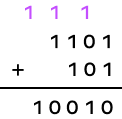
Therefore, $110_{2} + 111_{2} + 101_{2} = 1 0 0 1 0_{2}$
Practice Problems
Binary Addition: Conversion, Definition, Examples
The number system having a base _________ is called a binary number system.
The number system having a base “2” is called a binary number system. Binary number system employs 2 as the base and uses digits, 0 and 1.
If we add 0 and 1, the sum is ____ with carry ____ .
According to the binary addition rule, if the first binary number is 0, but the second binary number is 1 then the result of addition is 1 with carry 0. $0 + 1 = 1$ ; Carry $= 0$
In binary addition, $1 + 1 =$ ____.
According to binary addition rules, if both binary numbers are 1 then the result of addition is 10 with carry 1. The carry is forwarded to the next bit.
$1 + 1 = 0$ ; Carry $= 1 = 10$
$10_{2} + 01_{2} =$
Since $1 + 0 = 1$, we can write $10_{2} + 01_{2} = 11_{2}$
Frequently Asked Questions
What is the base in the number system?
Base or radix is defined as the number of different symbols used in the number system. In simpler words, the number of values that a character or digit can assume is known as the base or radix. It is represented by the “r” or “b.” Mathematically,
Base or Radix, $r = r\; -\; 1$
For example, the highest number system in binary is $(2\; -\; 1) =$ 1. So, the radix or base of the binary number system is 2.
What is binary overflow?
Sometimes, by adding two binary numbers, we can end up with an extra digit that doesn’t fit. This is called an overflow. The overflow error occurs when the addition result is bigger than the number of bits it can hold. An example is illustrated below.

Why do we use binary instead of decimal?
Binary system has two states: on and off. If computers were to use the decimal system, there would be 10 states instead and they would have to work a lot harder to process them all. Binary is easier for computers to process, and it also takes up less space.
How to convert decimal numbers to binary?
Let us understand this with the help of an example. Let us convert decimal number 2 to binary.The number 2 represents $2_{10}$, which is a decimal number. We know that the binary number system uses only two digits, such as 0 and 1. Hence, to convert 2 in a binary number system, we need to follow the following steps.
Step 1: Divide 2 by 2. The integer quotient obtained in this step is used as a dividend for the next step. Continue this process until we get the quotient becomes 0.

Step 2: Now, write the remainder in reverse chronological order, that is, from bottom to top.Hence, the decimal number 2 in binary is $10_{2}$.
How to use a binary addition calculator?
There are many online calculators available online that instantly add any two binary numbers. Check out this binary calculator. We just need to follow the steps given below:
1. Input the first binary number in the first field. You don’t need to enter leading zeros. For examfor “00001111,” you can input just “1111.”
2. Enter the second binary number in the second input box.3. The result will be displayed once you click on ‘Calculate’.





















